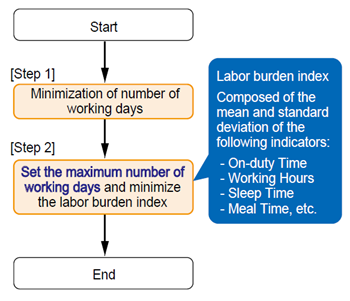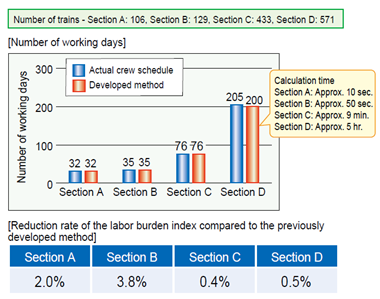18. Labor-saving for Generating Crew Schedule to Enable Workforce Efficiency and Reduce Labor Burden
During train timetable revisions, it is necessary to generate crew schedules that outline work plan, alongside train schedules and rolling stock schedules. Crew schedules must satisfy numerous regulatory constraints while ensuring workforce efficiency. In addition, reducing the labor burden on crew members is also required. As a result, even experienced personnel currently require several days or more to generate crew schedules for each rail line.
To date, we have developed an automated method for generating crew schedules focused specifically on workforce efficiency. However, since workforce efficiency and labor burden are in a trade-off relationship, the previously developed method struggled to balance both effectively, and faced significant increases in computation time on high-density lines. Therefore, we defined a new labor burden index representing factors such as on-duty time, working hours, sleep time, and meal time. Using mathematical optimization techniques, we developed a two-step solution method that first minimizes the number of working days, an indicator of workforce efficiency, and then reduces the labor burden index within the obtained upper limit of working days (Figure 1). This enables the generation of crew schedules that prioritize workforce efficiency while considering crew labor burden, all within a short time.
The developed method can generate the crew schedules in approximately five hours on a commercially available personal computer even for high-density lines with over 500 trains per day. Compared to actual crew schedules generated by personnel over several days, the method achieves equal or fewer working days while improving the labor burden index over the previously developed approach (Figure 2). This method enables labor-saving and de-skilling in the generation of crew schedules.
Other Contents
- 9. Design Method for Post-installed Anchor Joint Members in the Reconstruction of Concrete Structures
- 10. Reinforcement Method for Preventing Fatigue Cracks at Steel Girder Support Sections
- 11. Method for Identifying Potentially Critical Locations of Loose Bearing Based on On-board-measured Track Geometry
- 12. Extension of Rail Replacement Cycles Considering Fatigue/Soundness
- 13. Support Method for Extending Inspection Periods Based on Statistical Analysis of Equipment Inspection Records
- 14. Automated Visual Inspection System for Vehicle Underbody
- 15. Autonomous Train Operation System
- 16. General Purpose Real-time Algorithm for Generating Driving Curves for Driver Advisory System
- 17. Method for Updating On-board Databases Using Public Communication Networks
- 18. Labor-saving for Generating Crew Schedule to Enable Workforce Efficiency and Reduce Labor Burden
- 9. Design Method for Post-installed Anchor Joint Members in the Reconstruction of Concrete Structures
- 10. Reinforcement Method for Preventing Fatigue Cracks at Steel Girder Support Sections
- 11. Method for Identifying Potentially Critical Locations of Loose Bearing Based on On-board-measured Track Geometry
- 12. Extension of Rail Replacement Cycles Considering Fatigue/Soundness
- 13. Support Method for Extending Inspection Periods Based on Statistical Analysis of Equipment Inspection Records
- 14. Automated Visual Inspection System for Vehicle Underbody
- 15. Autonomous Train Operation System
- 16. General Purpose Real-time Algorithm for Generating Driving Curves for Driver Advisory System
- 17. Method for Updating On-board Databases Using Public Communication Networks
- 18. Labor-saving for Generating Crew Schedule to Enable Workforce Efficiency and Reduce Labor Burden


